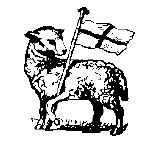Introducing the Book: New Testament
John's Further Writings
We've reached the last stage in our "Tour du Bible"! What were the highpoints of the journey (you may say "The End")? At what point did it seem particularly tough going? Are there any parts of the Bible you have found out about for the first time? Are there any parts you would like to follow up in a homegroup or sermon series?

I John
II John
III John
Revelation
a.k.a. the Apocalypse (from the Greek "apokalupto" - reveal, disclose)
What's in a name?
When you've been eating or drinking in a pub called the "Lamb & Flag" did you realise that its name referred to the Book of Revelation?
The lamb represents a sacrifice (John 1:29) and the flag is a banner of victory so the symbol reminds us of Jesus' victory over death (Rev. 5:12)
Now what about "The Pelican" near Ogmore Castle?
About the author In Mark 3:17 Jesus referred to John and his brother James as Boanerges ("Sons of Thunder"). In John 19:25 &26 he refers to himself as "the disciple Jesus loved".
What do these two things suggest about John's character?
Why was John special?
Does it disturb you that Jesus may have had favourites among his disciples?
- The Other Prologue
The most famous part of all John's writings is the Prologue to his Gospel, but the prologue to his epistle is almost as impressive. Read 1 John 1:1-4- What were John's motives for writing?
- What were his main themes?
- What was his authority for writing?
- The Primacy of Love
Read 1 John 4:7-21. A sermon on this passage might have as its headings:- The source of love
- The proof of love
- The effect of love
- The response to love
As well as what is said about love in this passage, there is another cause and effect statement within the passage which has staggering importance for us as Christians.
- What is it?
- Why is it so important?
- The Letters to the Seven Churches in Asia
The Book of Revelation is divided into two parts; in this part there are letters addressed to churches in the Roman province of Asia which is present-day Turkey. In these letters there are some debateable things and some incomprehensible things but also in each there are things which are clearly commended and things which are strongly criticised.
Read the letters to the churches at Ephesus (Rev. 2:1-7), Sardis (3:1-6) and Laodicea (3:14-22) and answer these questions about each of them:- What was there that was good?
- What needed to be dealt with?
- What does it have to say to us and our church?
- Visions of the End
Read Rev. 5:1 - 14. There are three songs of praise in these verses.- What principles for praise and worship can we draw from them for our own worship?
- Do any of the hymns and songs that we use come up to this standard?
- What might the four living creatures correspond to? (Clue in chapter 4)
- How do these verses help us to understand the picture of Jesus as a lamb?
- Why then should he be considered "worthy" (which is not an adjective usually applied to lambs)?